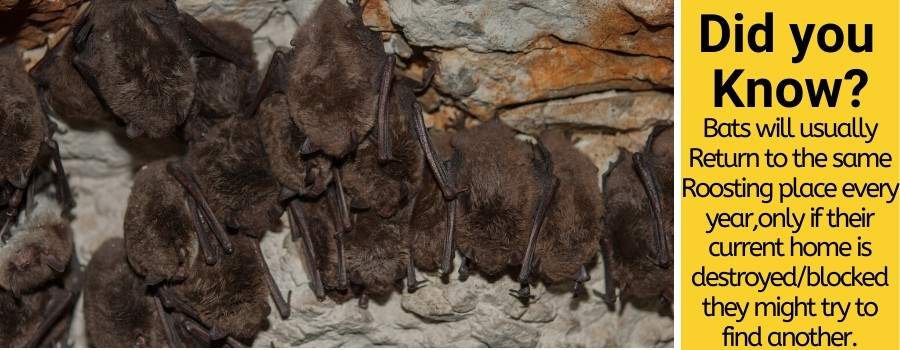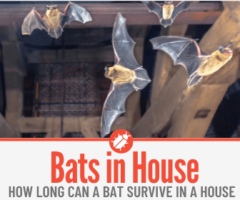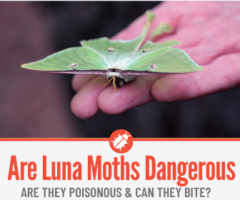 Bats are very mysterious creatures which in some cultures symbolises death or rebirth- hence gaining the nickname ‘guardian of the night’.
Bats are very mysterious creatures which in some cultures symbolises death or rebirth- hence gaining the nickname ‘guardian of the night’.
Bats, however, are highly intelligent and can habitat most dark areas. From your loft to huge caves, these bats can build their roosts (their equivalent of nests) in most dark places.
Bats live in a place called a Roost. In this article, we will see all about their Roosting Habits.
What Time Do Bats Return To Roost?
Bats will usually return to roost around early mornings or sunset. Though sometimes, especially in urban areas this may not happen due to streetlights and crowds.
Some bats, such as smaller brown bats, emerge from their roost usually two to three hours after dusk to get food. After feeding they return to their roosts to rest, and during the daytime they stay in their roosts to groom themselves, socialize or sleep.
Most bats are mostly active throughout the night, therefore being nocturnal creatures. Bats prefer darkness, especially in sheltered areas, since they can hide from predators such as big birds.
Where Do Bats Roost
Some bats like caves or hollow trees, as they feel protected from other predators, and they can socialize a lot easier. However, most bats shelter in buildings, behind tiles which are hanging, and in roof spaces. British Bats do not construct their own roosts, but rather use ones which are already made.
You will also find a lot of bats within underground sites, since this has similar conditions to a cave. When the weather temperature increases, (usually early summer), female bats will gather to create a maternity roost.
They will usually choose warm, dry areas such as a loft/attic. Females give birth to one pup (baby bat) a year, and usually will return to the same area each year to create the maternity roost.

How Long Do Bats Roost
Bats usually sleep lightly during daytime, as they are nocturnal creatures, and will come out around 15-30 minutes before the sun begins to set, so they can hunt for their prey (mainly insects). If you do see a bat flying about during the day, it may signal there is something wrong. A female bat during maternity may not even leave its roost at all!
The exact number of hours a bat roosts varies upon what season it is and what the temperature outside is. At the start of the year and at the end of the year, a bat is usually in hibernation. However, during the months of April or May, bats are fully active within feeding and can move from roost to roost if they wish.
How Far Do Bats Fly From Their Home
Male bats are usually the ones to fly out since they want to defend a roost. This can be done to protect it’s female companion, or even try attract a female bat during mating season!
A male bat is one of the biggest bats and can fly around 10 kilometres from their roost. However, during colder months or temperatures, a bat may only fly out a kilometre away from it’s roost for food or even not fly out at all!
When it is near hibernation season, a bat may travel out a bit more to find warmer shelter and food to store. In maternity season, a group of female bats may fly out to find a better environment to give birth.
Do Bats Come Back And Stay In The Same Roost
Bats are very loyal to their roost and will return to the same roost every year. However, most bats are very unlikely to stay in the same building all year round due to temperatures, mating seasons, maternity (females) and hibernation.
Bats are creatures of habit and strict routine. They will most likely roost together every year in the same area. When it is hibernation season, a bat may leave the roost to hibernate elsewhere such as hole in a tree. Then in April, the bats will return to their original roost which may be in your home! Same spot every year!
Furthermore, female bats will often choose the same area to give birth each year.
How To Stop And Deter Bats From Roosting In Your House
Unfortunately, within some countries such as the UK, you can’t do anything to deter or stop a bat by harming them. You can’t just go out there and buy a bottle of bat killer or a repellent similar to rat repellent etc.
It is about stopping them entering your house or keeping them away, as once they are in it can be hard and costly to get them out!
A simple method is to block where they come in and out. You can use an exit only type door/cover, meaning once the bats go out, they can’t come back in. However, do this after November and before April during the night as you do not want any baby bats being left behind!
Using non-toxic aerosols such as dog or cat repellents. You can spray the repellent during daytime, but only spray it when the bats are not present! It is a criminal offence in some countries and states to harm bats.
Continue Reading: How Long Can Bats live and Survive in your House
Where Do Bats Roost In Houses? How Can I Deter Them From My House?
Bats will tend to roost in the attic/loft of your house. It is usually the warmest area of the house as most heat is pushed up to the top. They can also roost in empty rooms and sometimes even attics/basements or gaps in between tiles, bricks etc.
They are most likely to roost in dry, warm environments where it is easy to access and there is not a lot of noises and people. Bats can roost both in new and old houses.
A pipistrelle bat is the most common bat found in houses. It only needs a 15mm long and 20mm wide hole, to get into your house. Therefore, they tend to choose smaller areas to roost. Another common example is the long-eared bats which tend to roost within lofts and attics as there is more heat and space.
Bats Roosting In Chimneys
Bats love to colonize and roost in chimneys. They are warm, safe and well protected from any predators. Therefore, so many female bats may choose a chimney to give birth. Bats can also use a chimney as a quick entrance and exit.
Fitting a Chimney screen or one-way door is a good idea, since bats can’t enter through it. However, you will have to do this at night when the bats have gone out, and usually after November to make sure you don’t block any baby bats who have not got wings yet.
However, it is rare that bats will roost in modern chimneys, since they are harder to access. Chimneys within old houses, usually have small gaps within the bricks or roof tiles, making it easier for the bat to roost itself. You can put non-toxic repellents down there such as dog repellent or you can use simple things such as cinnamon.
However, the chimney smells and the air may push those smells away. You do not want a bat dying in a chimney, as it will leave your house with horrid smells!
Bats will never usually use an active chimney since it will frighten them. A dis-used chimney is perfect for them, since it has rough insides in which they can hang off from and sleep.
Bats Roosting In Gable Vent
Bats roosting in Gable Vents, can be the worst thing! The sickening smell of guano will spread round the house easily! Bats of course roost in gable vents, since they are usually warm and dry, and they are quite easy to enter since they have small gaps.
Many people install Gable Vents in their attics for ventilation, however they forget one thing whilst doing it. A mesh screen! A mesh screen with small openings, is a fantastic way to keep bats away whilst keeping your house cooler.
If you have not put a mesh screen in, then expect bats to roost in your Gable Vent! Multiple holes are easily accessible to bats, and it leads to your attic usually, where it is dry and warm! Many females may use a Gable Vent, as an area in which they can give birth. It is very costly and hard to remove bats from a Gable Vent.
You need to place the mesh when you fit the vent or during hibernation at night if you haven’t done so. It is a cheap easy solution which will make all the difference.
Bats Roosting In The Attic
Bats also love to roost in the attic/loft. It is warm, dry and secure. You will usually find larger groups roosting in an attic/loft as there is more room. You will most likely hear bats moving about within the attic and see their droppings. You do not want bats in your attic at all, since their droppings can create fungus which causes respiratory issues.
A way to stop bats from roosting, is to cover all areas in which a bat could easily get through. Don’t disregard small gaps through the roof or the wall, as that is how the bat issue starts.
Furthermore, use simple smell repellents such as non-toxic cat/dog repellents, cinnamon etc may work, however you should not solely rely on them! Do not try using smoke or bright lights as this does not work!
Bats Roosting Under Eaves
Bats also roost under eaves. They are small secure spaces, which a bat can easily access. Fortunately, under eaves bats will not bother you at all. You can use things such as mothballs, or bright lights to deter the bats and keep them away, but that is wholly considered as inhumane and wont always work.
The best way mainly is to create a one-way exit only system within their roosts. This is the most humane way and will keep bats away- looking for a new roost.
Bats Roosting In your Porch
Bats also roost in porches. It is a safe way for them to rest as they are away from predators such as owls or hawks. Of course, bats on porches will bother you, as you will see them every time you exit and enter the house/garden. An easy solution to keep bats away from your porch, is securing Plexiglass to areas on the porch where they roost.
It is a lot harder for bats to grip when they sleep (since they sleep upside down). Bats can easily hang onto brick or wood as it is a dry non-slippery secure surface.
Bats Roosting Behind Shutters
Bats also roost behind shutters. Like gable vents, shutters have easily accessible small tiny holes which a bat can easily squeeze through. This will ultimately affect you, as you will see the bats near enough every day, and their guano is awfully close to you which could cause health issues.
A way to prevent this is small mesh screen covers between the vents which have tiny openings. Placing repellents there etc may not work since more bats could easily return once the repellent has died out.
What Does Bat Roosting Mean?
A bat lives in a place called a roost. A bat may have different roosts each year depending on the season and/or conditions. A female bat will roost in one area when it is giving birth, then roost in another area when she is hibernating. Roosting means settling in and congregating for rest. Roosting only happens with bats and sometimes birds.
Related Questions
Do Bats Live In The Desert?
Yes. The desert red bat lives in the desert. Unlike normal bats, they do not roost in caves. Instead they normally roost under leaves within the forest. The reason why they do this, is to protect themselves from other dangerous predators, or they are trying to eat.
The desert is a perfect daytime environment for a bat since it is very dry and hot. However, during the night it gets very cold, therefore the red desert bat must adapt.
Do Bats Live In Palm Trees?
There has been reports that some bats do live in palm trees. It has been reported as well that there has been a huge benefit from doing this. Less mosquitos, less hassle! They will usually roost within the skirts of the palm tree, since it is secure, dry and warm.
In Conclusion.
Bats are in every continent (except Antarctica), and in some countries are protected species. Bats then will roost in areas which a dark, easy to access and warm. The best way to keep bats out of your home, is to cover up areas which bats can easily get through.
Small cracks in the wall, roof and to cover up places like the chimney or Gable Vents with mesh cover with small openings.
If you do have a bat issue, the main advice is to call professionals. It is illegal to kill bats in some countries and states, and it is very inhumane! Killing a bat won’t do anything, as more can just enter. You need to get them carefully removed, and you need to get a professional to help you with closing potential gaps.
Across the internet, many people tell you to try lights, smells etc. Although some may work, they are mainly a temporary fix and sometimes can be inhumane or not work at all.
Bats do a lot to protect the environment and help with keeping pesky insects out. They are harmless (although some look deadly!). Only a reported 1% of bats carry rabies, but do not risk it! Never handle a bat yourself: get a professional in! Furthermore, bats can carry fleas, tics and more!
Something you do not want!
Bats hibernate throughout winter and are mainly active through summer/spring. If you do want to start covering up the house, you must do it within the winter period mainly at night.
The reason why, is that baby bats may be stuck in the roost when you close it, therefore they can’t escape and may die! A dead bat is not only illegal in some places, but also a huge issue! It will cause horrible odours within the house and could cause health issues with the guamo!






